-
Sound
Sound is a longitudinal wave transmitted by the oscillation of particles in a deformable medium.
-
Speed of sound equation

B is the bulk modulus
ρ is the density of the medium
-
Bulk modulus
A measure of the medium’s resistance to compression
-
Bulk modulus increases from _____ to _____ to _____.
gas to liquid to solid
-
The bulk modulus increases _____. Therefore, as one goes from gas to liquid to solid, sound travels fastest through a _____ and slowest through a _____.
disproportionately more than density
solid
gas
-
Speed of sound in air at 20°C
approximately 343 m/s
-
The speed of sound is fastest in a _____, and slowest in a _____.
solid with low density
very dense gas
-
Sound is produced by the _____ in a material along the sound wave’s direction of propagation.
mechanical disturbance of particles
-
The source of any sound is ultimately a _____
mechanical vibration of some frequency.
-
Sound is created by passing air between the _____, which are a pair of thin membranes stretched across the _____. As the air moves past these, they vibrate like the double reed of an oboe or bassoon, causing the air to _____.
vocal cords
larynx
vibrate at the same frequency
-
The pitch of the sound created by the vocal cords is controlled by varying the _____.
tension of the cords
-
Pitch
Our perception of the frequency of sound is called the pitch.
-
Infrasonic waves
Sound waves with frequencies below 20 Hz are called infrasonic waves.
-
Ultrasonic waves
Sound waves with frequencies above 20,000 Hz are called ultrasonic waves.
-
Frequency of ultrasound machines
up to ~2 GHz
-
Doppler effect
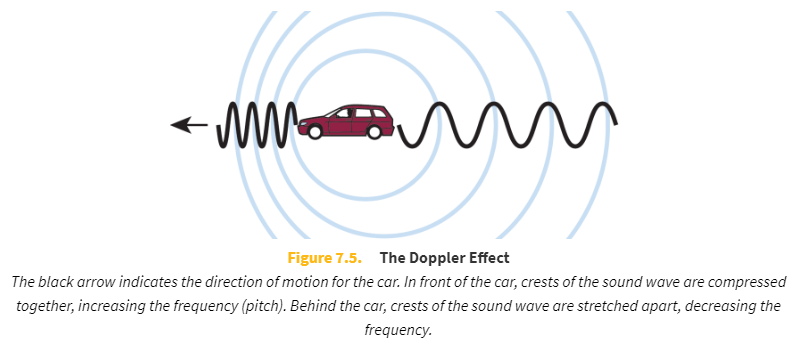
An increase (or decrease) in the frequency of sound, light, or other waves as the source and observer move toward (or away from) each other
-
Doppler effect equation

f′ is the perceived frequency
f is the actual emitted frequency
ν is the speed of sound in the medium
νD is the speed of the detector
νS is the speed of the source
The upper sign should be used when the detector or source is moving toward the other object. The lower sign should be used when the detector or source is moving away from the other object.
-
Blue shift and red shift
If a source of light is moving toward a detector, the observed frequency will increase. This is called blue shift because blue is at the high-frequency end of the visible spectrum. If the source is moving away from the detector, the observed frequency will decrease, causing red shift.
-
MNEMONIC: Sign convention in the Doppler equation:
Top sign for “toward"
Bottom sign for “away”
-
Echolocation
In echolocation, the animal emitting the sound (usually a dolphin or bat) serves as both the source and the detector of the sound. The sound bounces off of a surface and is reflected back to the animal. How long it takes for the sound to return, and the change in frequency of the sound, can be used to determine the position of objects in the environment and the speed at which they are moving.
-
Shock wave
An object that is producing sound while traveling at or above the speed of sound allows wave fronts to build upon one another at the front of the object. This creates a much larger amplitude at that point. Because amplitude for sound waves is related to the degree of compression of the medium, this creates a large pressure differential or pressure gradient. This highly condensed wave front is called a shock wave.
-
Sonic boom
The passing of a shock wave creates very high pressure, followed by very low pressure, which is responsible for the phenomenon known as a sonic boom.
-
Once an object moves faster than the speed of sound, some of the effects of the shock wave are mitigated because ...
... all of the wave fronts will trail behind the object, destructively interfering with each other.
-
Loudness or volume
The loudness or volume of a sound is the way in which we perceive its intensity. It is subjective.
-
Intensity
Intensity is the average rate of energy transfer per area across a surface that is perpendicular to the wave. In other words, intensity is the power transported per unit area.
-
SI units for intensity of sound

-
Intensity equation

P is the power
A is the area
-
The amplitude of a sound wave and its intensity are also related to each other: intensity is proportional to _____.
the square of the amplitude
-
Doubling the amplitude of a sound wave produces a sound wave that has _____ the intensity.
four times
-
Intensity of a sound is _____ the distance from the source.
inversely proportional to the square of
-
The softest sound that the average human ear can hear has an intensity equal to about _____.
1 x 10-12 W/m2
-
Intensity at the human threshold of pain
10 W/m2
-
Intensity of sound that causes instant perforation of the eardrum
1 x 104 W/m2
-
Sound level
To make the range of intensity easier to work with, we use a logarithmic scale, called the sound level (β), measured in decibels (dB).
-
Sound level equation

I is the intensity of the sound wave
I0 is the threshold of hearing (1 x 10-12 W/m2)
-
Final sound level equation

If/Ii is the ratio of the final intensity to the initial intensity
-
Threshold of pain in decibels
130
-
Eardrum perforation in decibels
160
-
Damping, or attenuation
The loss of intensity due to non-conservative forces such as friction, air resistance, and viscous drag in the medium.
-
After the decrease in intensity associated with distance, real world measurements of sound will be _____ than those expected from calculations.
lower
-
Damping _____ on the frequency of the wave, so the pitch _____.
does not have an effect
will not change
-
Over small distances, attenuation is usually _____.
negligible
-
Beat
An interference pattern between two sounds of slightly different frequencies, perceived as a periodic variation in volume whose rate is the difference of the two frequencies
-
Beat frequency equation

f1 and f2 represent the two frequencies that are close in pitch
fbeat represents the resulting beat frequency
-
Standing waves are produced by ...
... the constructive and destructive interference of a traveling wave and its reflected wave.
-
MNEMONIC: Nodes are places of _____.
No Displacement
-
Standing waves appear to be standing still—that is, not propagating—because the interference of the wave and its reflected wave produce a resultant that _____.
fluctuates only in amplitude
-
Closed boundaries
Closed boundaries are those that do not allow oscillation and that correspond to nodes. The closed end of a pipe and the secured ends of a string are both considered closed boundaries.
-
Open boundaries
Open boundaries are those that allow maximal oscillation and correspond to antinodes. The open end of a pipe and the free end of a flag are both open boundaries.
-
Objects that support standing waves have _____ at both ends.
boundaries
-
On a sine wave, the distance from one node to the next node is _____.
one-half of a wavelength
-
Equation relating the wavelength λ of a standing wave and the length L of a string that supports it

n is a positive nonzero integer (n = 1, 2, 3, and so on) called the harmonic
-
Frequencies of a string equation

n is a positive nonzero integer (n = 1, 2, 3, and so on) called the harmonic
-
Fundamental frequency
The lowest frequency (longest wavelength) of a standing wave that can be supported in a given length of string is known as the fundamental frequency (first harmonic).
-
The frequency of the standing wave given by n = 2 is known as the _____ or _____.
first overtone or second harmonic
-
Harmonic series
All the possible frequencies that the string (or pipe, or whatever) can support form its harmonic series.
-
For strings attached at both ends, the _____ will tell you which harmonic it is.
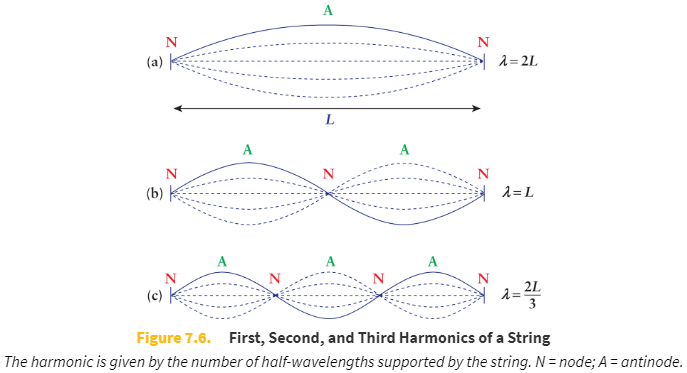
number of antinodes present
-
Open pipes
Pipes that are open at both ends
-
Closed pipes
Pipes that are closed at one end and open at the other
-
An open pipe, being open at both ends, has _____ at both ends
antinodes
-
Relationship between the wavelength λ of a standing wave and the length L of an open pipe that supports it

n is a positive nonzero integer (n = 1, 2, 3, and so on) called the harmonic
-
Possible frequencies of an open pipe equation

n is a positive nonzero integer (n = 1, 2, 3, and so on) called the harmonic
-
For open pipes, the _____ will tell you which harmonic it is.
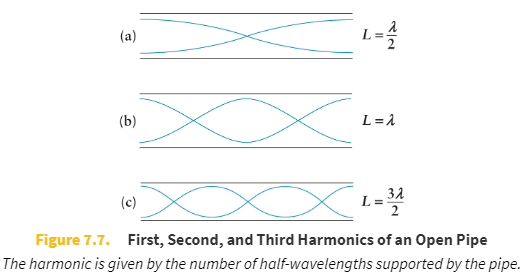
number of nodes present
-
Overtone
A wavelength which is a part of the harmonic series above a fundamental note
-
In the case of a closed pipe, the closed end will correspond to a _____, and the open end will correspond to a _____.
node
antinode
-
Because the closed end must always have a node and the open end must always have an antinode, there can only be _____.
odd harmonics
-
Equation relating the wavelength of a standing wave and the length of a closed pipe that supports it

n can only be an odd integers (n = 1, 3, 5, and so on)
-
Frequency of the standing wave in a closed pipe equation

n can only be an odd integers (n = 1, 3, 5, and so on)
-
When presented with a closed pipe, make sure to actually count the _____ contained in the pipe to determine the harmonic.
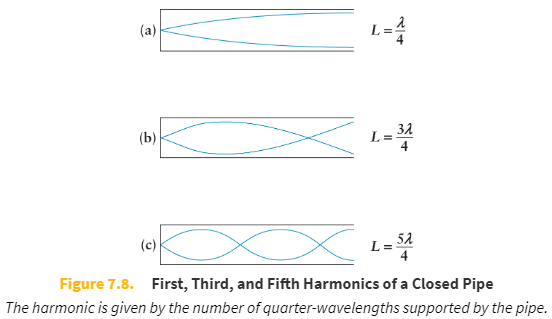
number of quarter-wavelengths
-
Ultrasound
Ultrasound uses high frequency sound waves outside the range of human hearing to compare the relative densities of tissues in the body.
-
Ultrasound ultimately relies on _____; thus, an _____ between two objects is necessary to visualize anything.
reflection
interface
-
An ultrasound machine consists of a _____ that generates a _____, which also functions as a _____ that _____.
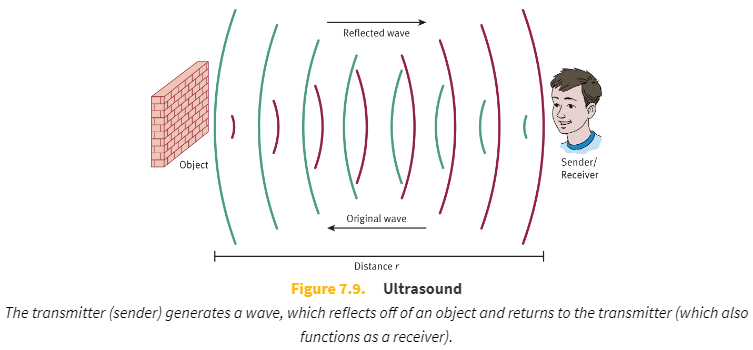
transmitter, pressure gradient
receiver, processes the reflected sound
-
Doppler ultrasound
Doppler ultrasound is used to determine the flow of blood within the body by detecting the frequency shift that is associated with movement toward or away from the receiver.
-
How can ultrasound be used therapeutically?
Ultrasound waves create friction and heat when they act on tissues, which can increase blood flow to a site of injury in deep tissues and promote faster healing.
Focused ultrasound using a parabolic mirror causes constructive interference at the focal point of the mirror.
-
Phacoemulsification
Destruction of cataracts through focused ultrasound
-
Lithotripsy
A procedure that uses focused ultrasound to break up stones in the kidney and parts of the ureter
-
High-intensity focused ultrasound (HIFU)
A non-invasive therapeutic technique that uses non-ionizing ultrasonic waves to heat or ablate tissue, such as tumors

